A Dutch oven is a thick-walled cooking pot with a tight-fitting lid. Most Dutch ovens use seasoned cast iron; others use cast aluminum or ceramic. Some metal types are called French ovens because they are enameled rather than seasoned. For hundreds of years, Dutch ovens have been used as cooking containers.
People call them casserole dishes in English-speaking nations other than the United States. They have a connection to the South African ‘potjie,’ the Australian’ Bedourie oven,’ and the Spanish ‘cazuela’ and are comparable to both the Japanese tetsunabe and the ‘sa,’ a traditional Balkan cast-iron dutch oven.
Use In Cooking
Dutch oven cooking is ideal for long, low-temperature cooking (slow cooker), such as roasts, stews, and casseroles. So, what can you cook in a Dutch oven. Well you can prepare almost any recipe you can cook in a regular oven in a Dutch oven. You can use old-style lipped cast-iron Dutch ovens as actual baking ovens while cooking over a campfire to make biscuits, cakes, pizzas, pies, and even baking bread.
As you finish the first batch, you can place a smaller baking pan within the ovens before being changed with another. It’s also feasible to stack Dutch ovens on top of one another, retaining the heat that would otherwise escape through the hot coals on top. These piles can reach five or six pots high.
History Of The Dutch Oven
The history of the Dutch oven is almost as fascinating as the iconic, beautiful piece of cookware itself. Given that traditional Dutch dishes aren’t making appearances in these ovens, how did it get its name? Though no one can be certain, Le Creuset prefers the following explanation: The Dutch were the first to abandon traditional clay molds to cast metal in sand molds in the 17th century.
This made it possible for iron cookware to have smoother finishes. Others claim that a British observer saw the procedure and brought it back to England. In contrast, others argue that the name came from Dutch traders carrying these pots. Le Creuset was supplying French restaurants with pots and pans by the 1920s.
Things You Should Know Before You Cook With a Dutch Oven
Low and Slow Is Where It’s At
One of the essential advantages of utilizing a Dutch oven is its capacity to maintain heat for an extended period. While you might be used to raising the heat on your stockpot to a maximum, since a Dutch oven retains heat, you don’t have to raise the temperature to extremes. Instead, allow your braised dishes (such as short ribs or pot roast) to simmer low and slow for several hours to ensure tender, fall-off-the-bone marvels every time. For even more tasty and juicy foods, don’t forget to use the lid to create steam and trap moisture.
Use It as a Tool to Develop the Flavors in a Dish
Unlike a traditional slow cooker, a dutch oven allows you to enhance the rich flavors in a recipe by mixing numerous cooking techniques, such as searing and sautéing, with braising, making flavorful sauce. To encourage the Maillard reaction, sear or brown your proteins for stronger, more mouthwatering recipes. Because the interaction between amino acids and sugars reduces when we cook at high temperatures, this approach aids in the development of flavor complexity.
Make Sure All the Parts Are Oven-Safe.
Dutch ovens are fantastic for stews and soups, but did you know you can also use them for baking? Make fresh loaves of bread from the comfort of your own home by quickly transforming your kitchen into a bakery with your dutch oven. However, before you begin any cooking project, make sure that all of the components of your dutch oven are oven-safe at high temperatures. The usual plastic knobs on a dutch oven are typically oven safe up to 390°F. Use a replacement knob to handle the heat when creating no-knead bread that demands higher cooking temperatures.
What Do You Usually Cook in a Dutch Oven?
Cast iron dutch ovens are substantial pieces, especially when the volume is in the 6 or 7-quart range. They’re also quite attractive, so many cooks prefer to keep them out on the stovetop—undeniably valuable kitchen real estate! So, make sure your Dutch oven earns its spot on the stove by cooking up some tremendous daily dishes that put it to good use.
First, what Is a Dutch Oven? Essentially a Dutch oven is a heavy-duty cooking pot with a lid. You can use a Dutch oven for cooking delicious meals in a wide variety of cooking methods: Dutch ovens can sauté, simmer, braise, sear, fry, and even bake food. Not only are Dutch ovens heavy-duty, but they are also virtually all-purpose. Here are some interesting dutch oven recipes.
Macaroni and Cheese
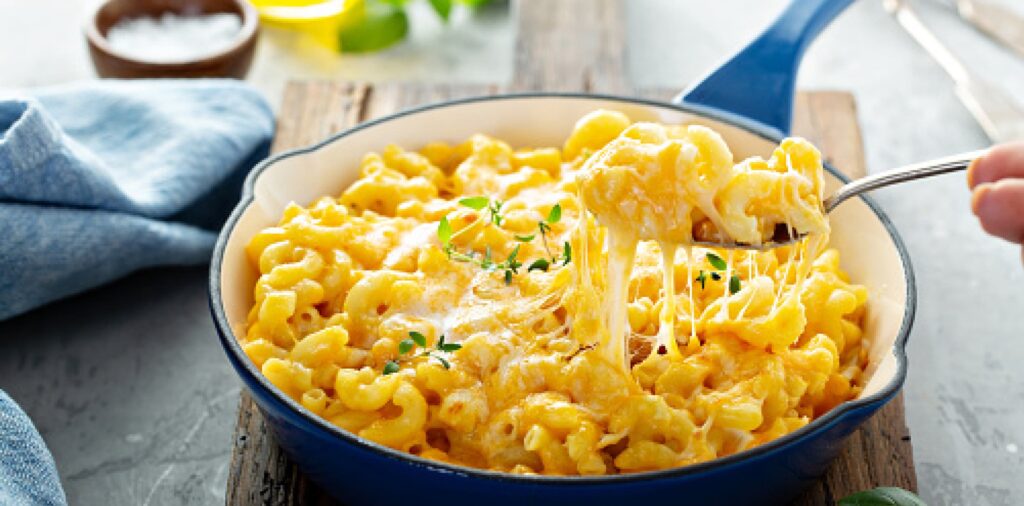
Consider a smaller Dutch oven (or micro ones!) if you have the space and resources. You’ll find yourself using it frequently and serving it to guests on a trivet. In this dishware, any dish with a béchamel foundation turns out nicely.
You don’t want that sauce to burn, so these pots are designed to have no hot spots, distribute heat evenly, and prevent sticking. A béchamel base is also used in some of the tastiest mac ‘n cheese we’ve ever had. So put your feet up, utilize this pot, transfer it from cooktop to oven, and serve it to your guests. It’s finished.
Scalloped Potatoes
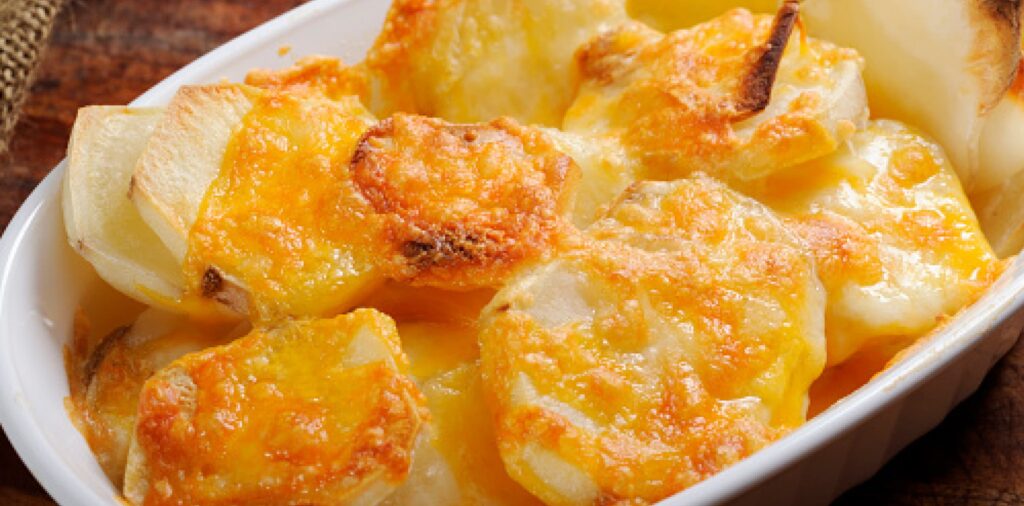
Although they are known as Dutch ovens, these beauties are most known for housing French food. This classic scalloped potato (not mashed potatoes) and leek dish begins with a roux base (butter and flour swirled together ), which is excellent for making in a saucepan that doesn’t burn easily.
Don’t forget to subject your side dishes to the Dutch oven treatment and place it in the center of the dinner table with metal utensils.
In this take on traditional scalloped potatoes, we use crème fraîche to thicken the white sauce and add sweet leeks and a trio of fragrant herbs to the potatoes. Everything from a Christmas prime rib or ham to a simple roast chicken goes well with this warm side dish.
Dorie Greenspan’s Roast Chicken
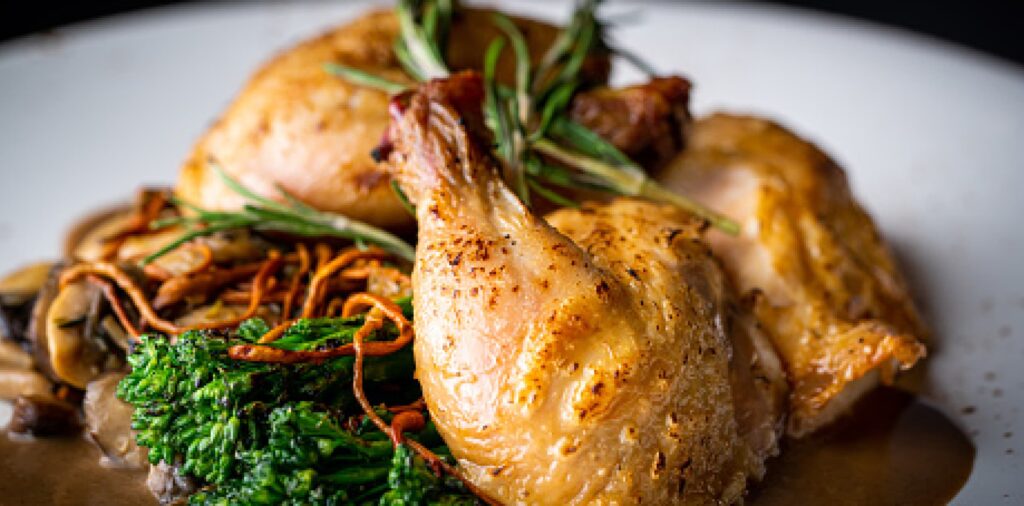
This roast chicken from Dorie Greenspan’s new cookbook, Everyday Dorie, is classic and straightforward. Still, she elevates it with a few distinctive touches. “You’ll make this recipe once and then never look at it again,” she writes in the book, and she’s right.
It only takes one try to grasp her clever strategies, and they’re so simple that you’ll memorize them for the next time. An herb-loaded compound butter and a slice of homemade bread make Dorie’s roast chicken wonderful (flavorful meat).
- First, combine any herbs on hand with lemon zest, scallions, and butter (I used tarragon, parsley, and basil).
- You’ll think you have too many spices for the amount of butter, but trust us when we say it works, so keep mashing.
- Then prop up the chicken on a slice or two of stale bread in a Dutch oven.
- The whole chicken can virtually baste itself thanks to the high edges of the Dutch oven.
- The bread holds the chicken in place and soaks up so much of the drippings that it’s completely soaked when it is done cooking with a thin layer.
- The bread isn’t the prettiest thing to give to guests, but it’s probably the tastiest component of the whole dish, so keep it for yourself and eat it in the kitchen. Garnish with chopped cilantro.
Strata
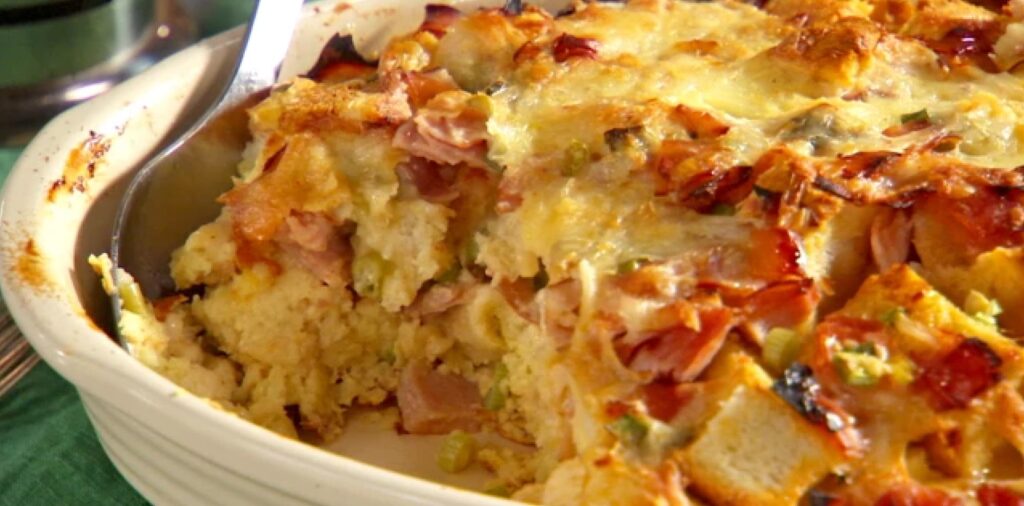
- First, preheat the oven to 350 degrees Fahrenheit (180 degrees Celsius). Butter a new dutch oven with 3 1/2 quarts (3.5 liters).
- Then on a baking sheet, arrange the bread cubes in a single layer. Bake it for 6 to 8 minutes, or until gently browned.
- Allow it to cool. Then, preheat the oven to 350 degrees Fahrenheit (180 degrees Celsius). After, warm the olive oil in a sauté pan over medium heat.
- Then, cook, occasionally turning, until softened, approximately 2 minutes, with the shallot and a touch of salt and pepper.
- Then, cook, occasionally stirring, until the mushrooms are golden brown and soft, about 5 minutes. Place in a bowl and set aside to cool.
- Whisk together the milk, eggs, mustard, lemon zest (some secret ingredient), and cheese in a large mixing basin until well blended.
- Season with salt and pepper and balsamic vinegar after adding the tarragon. Place the bread cubes in the Dutch oven that you prepare.
- Toss in the mushrooms and asparagus to mix. Pour the milk mixture over the bread mixture and whisk to coat it thoroughly.
- Allow 30 minutes for the mixture to come to room temperature. Bake for about 40 minutes, or until the egg mixture sets and the top of the strata is golden brown.
- Warm the dish before serving.
Fried Chicken
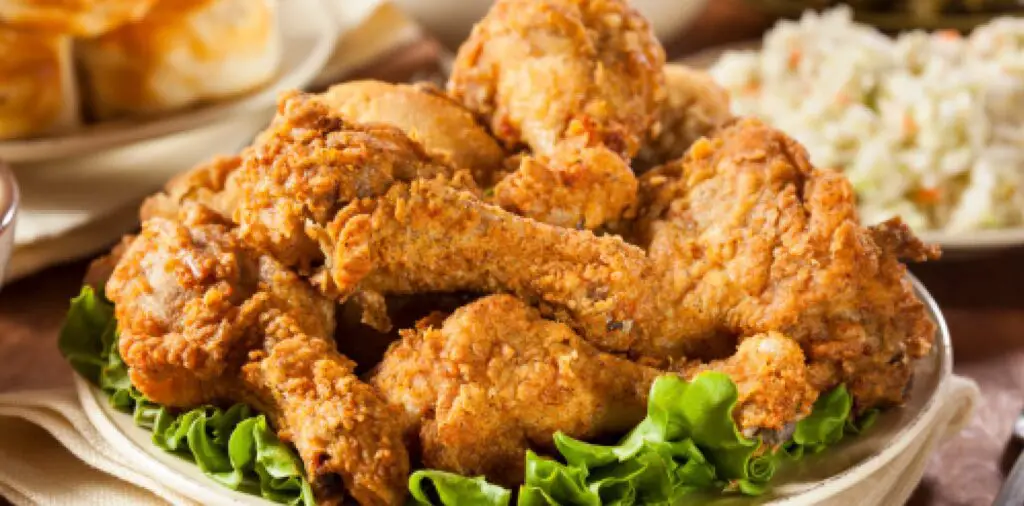
To make the buttermilk brine:
- Whisk together the buttermilk and 1/3 cup salt in a large mixing dish.
- Crush the oregano, thyme, rosemary, and sage in a mortar with a pestle (or pulse in a spice grinder) until finely powdered.
- Remember to cook it on slow flame for deep frying.
- Whisk together the ground herbs, garlic, and cayenne pepper in a separate bowl.
- Reserve the back and giblets for later use and cut the chicken into 2 thighs, 2 drumsticks, 2 wings, and 2 breast halves.
- For 10 chicken pieces, cut each breast half crosswise into 4 breast portions.
- Place the chicken in the buttermilk brine, ensuring it is well submerged. (If it’s not, put everything in a smaller bowl.)
- Refrigerate for at least 4 hours or up to 6 hours, covered.
Seafood Stew
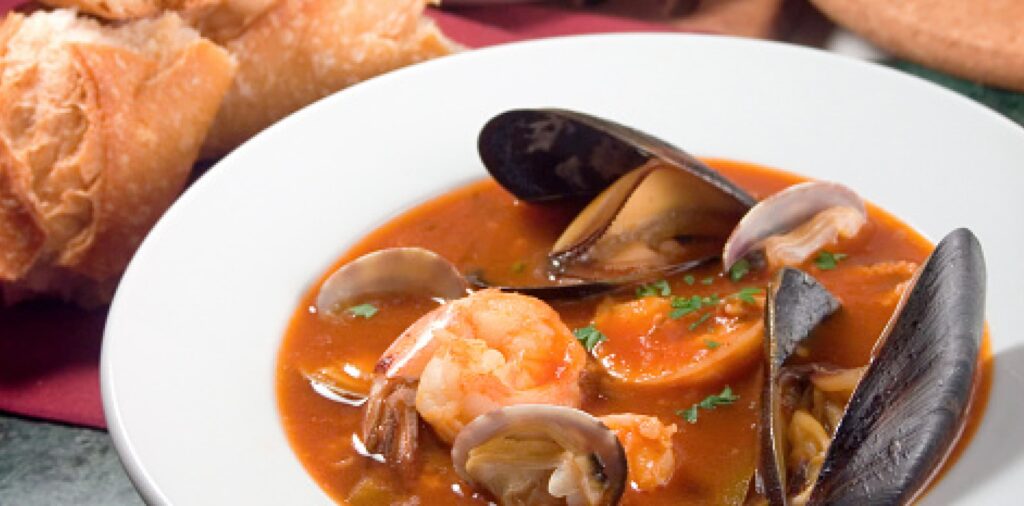
- Warm the olive oil in a large Dutch oven or other deep, heavy pot over medium-high heat. Add the onion and garlic and cook for 4 minutes, or until the onion is tender.
- Add the tomatoes and red pepper flakes and cook for 5 minutes, or until the tomatoes soften.
- Bring the tomato sauce and wine to a boil together. Reduce to medium-low heat, cover, and simmer for 10 minutes.
- Cover and cook for 10 minutes with the squid. Cover and simmer the white fish, scallops, and shrimp for about 10 minutes, or until the shrimp and scallops are opaque throughout but still soft.
- Rub a garlic clove half thoroughly on one side of each bread slice.
- Place each piece in a warmed broad, shallow soup dish, garlic side up.
- Pour a quarter of the stew into each bowl, evenly dividing the fish and shellfish.
- Serve immediately with a parsley garnish.
What Can You Not Cook in a Dutch Oven?
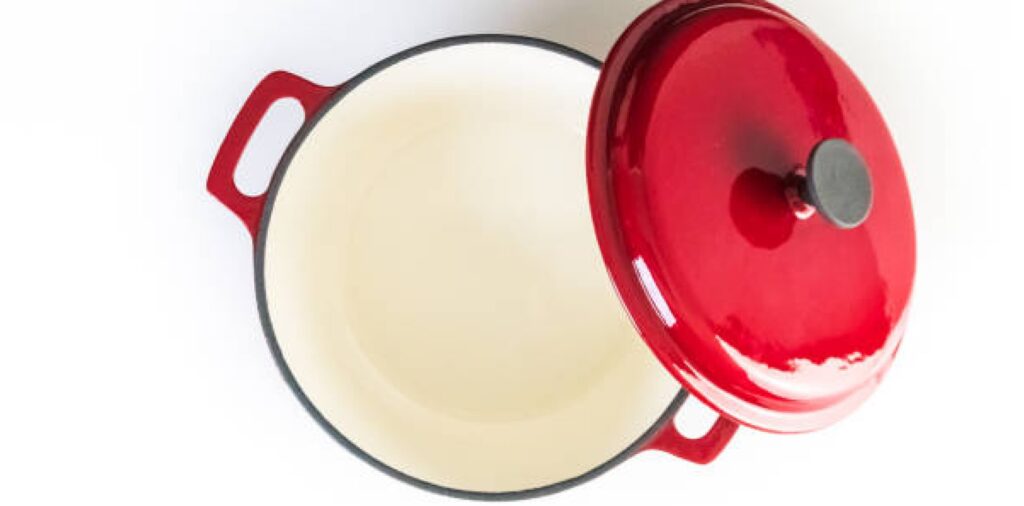
In any chef’s kitchen, cast-iron cookware is a must-have. You can use it on the stovetop, oven, or even deep-fryer. Not to mention the excellent results campers and other camp cooking lovers achieved when using cast-iron cookware over open flames or briquettes.
Some dishes, however, should never be cooked in a cast-iron pot or skillet.
You should not cook tomatoes, lemons, other citrus fruits, and delicate proteins like white flaky fish and eggs. Avoid sticky items such as desserts with sweet sauces before seasoning your cast-iron Dutch oven, skillet, or pan.
No sticky foods like :
- BBQ Sauce
- Tomato sauce
- Honey
- Maple syrup
- Molasses
- Candy
- Caramel sauce
- Oily & fatty foods
Seasoning And Care
Bare Cast Iron Dutch Oven
Dutch ovens are traditionally seasoned like other cast-iron cookware. Dutch ovens are typically cleaned the same way as other cast-iron cookware: with boiling water and a gentle brush or sponge after each use. A cleaned and newly oiled Dutch oven should be placed in a clean, dry environment with the lid ajar or off to improve air circulation and avoid the smell and taste of rancid oil.
If you must let the lid be left open on the Dutch oven, you should place a paper towel or piece of the newspaper within to absorb any moisture. The surfaces of the Dutch oven will turn dark black, very smooth, shiny, and non-stick after extensive usage if handled with care. A Dutch oven will last a long time if kept properly.
Enameled Ovens
Before using enameled ovens, they do not need to be seasoned. They do, however, lose some of the benefits of naked cast iron. You can generally clean enameled ovens the same way as regular cookware can, and you can even put some brands in the dishwasher.
Final Words – What Can You Cook in a Dutch Oven?
A Dutch oven is a heavy-duty pot with a lid used to brown meat and vegetables before boiling or braising them in the oven. You can also use it to make soup and carry out more basic activities such as boiling noodles. It’s also commonly used to create bread and some dutch oven recipes or vegetarian recipes.
Dutch ovens resemble stockpots but have wider bases and slightly shorter but thicker walls. This allows for greater browning and caramelization of foods while also retaining heat and serving as serving pieces that keep meals warm at the table. They also include two small handles on each side (instead of one long on standard pans) for balanced and stable oven transfer.
